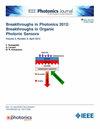Multi-Physics Field Based Simulation on the Response and Saturation Properties of Hg1-xCdxTe Based Photovoltaic Detectors With Composition Gradients
IF 2.1
4区 工程技术
Q3 ENGINEERING, ELECTRICAL & ELECTRONIC
引用次数: 0
Abstract
In recent years, there has been a growing interest in photovoltaic detectors based on mercury cadmium telluride (Hg 1-x Cd x Te), owing to their exceptional photoelectric properties. To provide the physical insights into the modulation effects of Cd composition基于多物理场模拟的具有成分梯度的 Hg1-xCdxTe 光伏探测器的响应和饱和特性
近年来,基于碲化镉汞(Hg1-xCdxTe)的光电探测器因其卓越的光电特性而受到越来越多的关注。为了深入了解镉成分 x 在强注入条件下对 Hg1-xCdxTe 的调制效应,特别是对中波红外 HgCdTe 探测器的调制效应,我们进行了数值模拟,研究光场和电场对探测器性能的耦合效应。我们比较了基于三种耦合方向(即反向场 (IF)、垂直场 (VF) 和平行场 (PF))的 Hg1-xCdxTe 探测器的响应率和饱和阈值,并考虑了前照 (FI) 和背照 (BI) 下成分梯度和外加偏置电压所产生的电场贡献。考虑到调制效应的模拟结果表明,探测器在前照情况下具有更好的光电响应特性,而在背照情况下具有更高的饱和阈值。在照明强度低于 20 W/cm2 时,IF 结构具有最佳的电流响应,非线性模型的峰值响应率超过 2.8 A/W。VF 结构在照明强度高于 20 W/cm2 时具有最佳的电流响应,并表现出最佳的饱和特性,其饱和阈值始终高于 15 W/cm2,而具有非线性递增(nInc)成分梯度的 PF 结构在高照明强度条件下表现出卓越的线性响应。仿真方法有助于根据具体要求,在物理理解的基础上设计和优化探测器。
本文章由计算机程序翻译,如有差异,请以英文原文为准。
求助全文
约1分钟内获得全文
求助全文
来源期刊

IEEE Photonics Journal
ENGINEERING, ELECTRICAL & ELECTRONIC-OPTICS
CiteScore
4.50
自引率
8.30%
发文量
489
审稿时长
1.4 months
期刊介绍:
Breakthroughs in the generation of light and in its control and utilization have given rise to the field of Photonics, a rapidly expanding area of science and technology with major technological and economic impact. Photonics integrates quantum electronics and optics to accelerate progress in the generation of novel photon sources and in their utilization in emerging applications at the micro and nano scales spanning from the far-infrared/THz to the x-ray region of the electromagnetic spectrum. IEEE Photonics Journal is an online-only journal dedicated to the rapid disclosure of top-quality peer-reviewed research at the forefront of all areas of photonics. Contributions addressing issues ranging from fundamental understanding to emerging technologies and applications are within the scope of the Journal. The Journal includes topics in: Photon sources from far infrared to X-rays, Photonics materials and engineered photonic structures, Integrated optics and optoelectronic, Ultrafast, attosecond, high field and short wavelength photonics, Biophotonics, including DNA photonics, Nanophotonics, Magnetophotonics, Fundamentals of light propagation and interaction; nonlinear effects, Optical data storage, Fiber optics and optical communications devices, systems, and technologies, Micro Opto Electro Mechanical Systems (MOEMS), Microwave photonics, Optical Sensors.
 求助内容:
求助内容: 应助结果提醒方式:
应助结果提醒方式:


